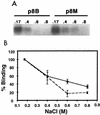A single amino acid change in turnip crinkle virus movement protein p8 affects RNA binding and virulence on Arabidopsis thaliana
- PMID: 9621099
- PMCID: PMC110452
- DOI: 10.1128/JVI.72.7.6247-6250.1998
A single amino acid change in turnip crinkle virus movement protein p8 affects RNA binding and virulence on Arabidopsis thaliana
Abstract
Comparison of the symptoms caused by turnip crinkle virus strain M (TCV-M) and TCV-B infection of a resistant Arabidopsis thaliana line termed Di-17 demonstrates that TCV-B has a greater ability to spread in planta. This ability is due to a single amino acid change in the viral movement protein p8 and inversely correlates with p8 RNA binding affinity.
Figures



Similar articles
-
Cell-to-cell movement of turnip crinkle virus is controlled by two small open reading frames that function in trans.Virology. 1998 May 10;244(2):405-16. doi: 10.1006/viro.1998.9125. Virology. 1998. PMID: 9601509
-
RNA silencing-suppressor function of Turnip crinkle virus coat protein cannot be attributed to its interaction with the Arabidopsis protein TIP.J Gen Virol. 2004 Nov;85(Pt 11):3415-3420. doi: 10.1099/vir.0.80326-0. J Gen Virol. 2004. PMID: 15483259
-
Satellite RNA-mediated resistance to turnip crinkle virus in Arabidopsis involves a reduction in virus movement.Plant Cell. 1997 Nov;9(11):2051-63. doi: 10.1105/tpc.9.11.2051. Plant Cell. 1997. PMID: 9401127 Free PMC article.
-
The capsid protein p38 of turnip crinkle virus is associated with the suppression of cucumber mosaic virus in Arabidopsis thaliana co-infected with cucumber mosaic virus and turnip crinkle virus.Virology. 2014 Aug;462-463:71-80. doi: 10.1016/j.virol.2014.05.031. Epub 2014 Jun 17. Virology. 2014. PMID: 25092463
-
3'UTRs of carmoviruses.Virus Res. 2015 Aug 3;206:27-36. doi: 10.1016/j.virusres.2015.01.023. Epub 2015 Feb 4. Virus Res. 2015. PMID: 25662021 Review.
Cited by
-
Analyses of RNA-Seq and sRNA-Seq data reveal a complex network of anti-viral defense in TCV-infected Arabidopsis thaliana.Sci Rep. 2016 Oct 26;6:36007. doi: 10.1038/srep36007. Sci Rep. 2016. PMID: 27782158 Free PMC article.
-
Isolation of an Arabidopsis thaliana mutant in which the multiplication of both cucumber mosaic virus and turnip crinkle virus is affected.J Virol. 1998 Nov;72(11):8731-7. doi: 10.1128/JVI.72.11.8731-8737.1998. J Virol. 1998. PMID: 9765416 Free PMC article.
-
Complete nucleotide sequence and genome organization of hibiscus chlorotic ringspot virus, a new member of the genus Carmovirus: evidence for the presence and expression of two novel open reading frames.J Virol. 2000 Apr;74(7):3149-55. doi: 10.1128/jvi.74.7.3149-3155.2000. J Virol. 2000. PMID: 10708431 Free PMC article.
-
Membrane insertion and biogenesis of the Turnip crinkle virus p9 movement protein.J Virol. 2010 Jun;84(11):5520-7. doi: 10.1128/JVI.00125-10. Epub 2010 Mar 24. J Virol. 2010. PMID: 20335263 Free PMC article.
-
Influence of viral genes on the cell-to-cell spread of RNA silencing.J Exp Bot. 2008;59(10):2803-13. doi: 10.1093/jxb/ern141. Epub 2008 May 31. J Exp Bot. 2008. PMID: 18515824 Free PMC article.
References
-
- Altenbach S, Howell S H. Identification of a satellite RNA associated with turnip crinkle virus. Virology. 1981;112:25–33. - PubMed
-
- Carrington J C, Heaton L A, Zuidema D, Hillman B I, Morris T J. The genome structure of turnip crinkle virus. Virology. 1989;170:219–226. - PubMed
-
- Citovsky V, Knorr D, Schuster G, Zambryski P. The P30 movement protein of tobacco mosaic virus is a single-strand nucleic acid binding protein. Cell. 1990;60:637–647. - PubMed
Publication types
MeSH terms
Substances
LinkOut - more resources
Full Text Sources

